Teodorescu P.P. Mechanical Systems, Classical Models Volume I: Particle Mechanics
Подождите немного. Документ загружается.

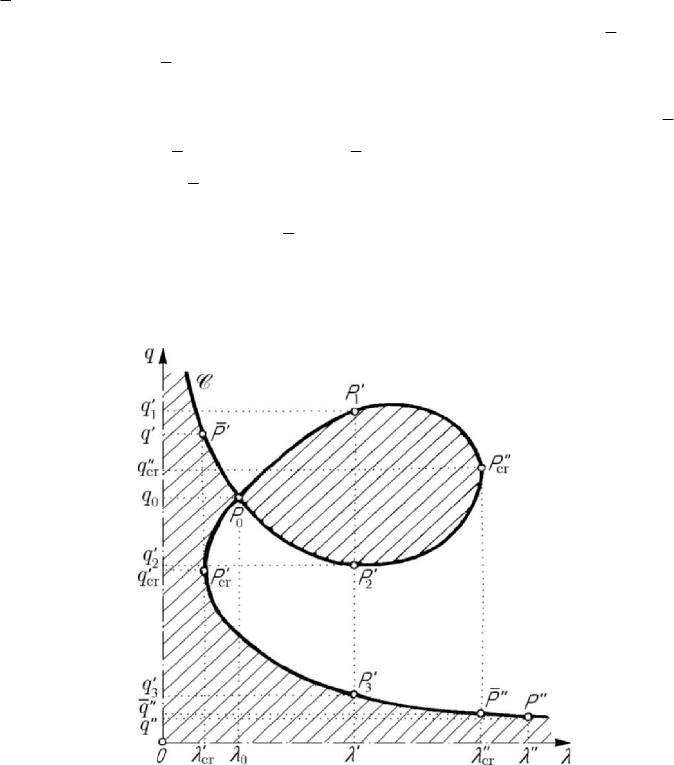
Problems of dynamics of the particle
461
h being a non-dimensional constant, while α is the amplitude. Representing 2()V θ
as a function of
θ
(Fig.7.22), we see that the motion takes place only for
[]
1,1h ∈− ;
we may have also
1h > , but it does not correspond to a real angle α , the motion
being – in this case – circular. The condition
2()Vhθ
≤
allows to draw the curves
()ppθ= , symmetric with respect to the Oθ -axis, function of various values of h , in
the phase space. For
(1,1)h ∈− , e.g., for 0h
=
, the motion is oscillatory (we have a
simple pendulum). If
1h =
, then the motion is asymptotic, obtaining the lines of
separation (drawn with a thicker line) in the phase space; for
απ
=
it corresponds a
labile position of equilibrium. For
1h
=
− it results a stable position of equilibrium (a
point in the phase space), corresponding
0α
=
. Noting that, for 0p > , q increases at
the same time as
t , we have indicated by an arrow the direction of the motion in the
phase space.
Figure 7.23. Topological structure of a phase trajectory depending on a parameter.
We notice that the separation lines are phase trajectories of the representative point
in the phase space; they do not allow to pass from a type of motion to another one. We
have seen that a singular point is specified by the equations
() 0
f
q
=
, 0p = , all the
other points being ordinary points; it results that an ordinary point is characterized by a
well defined direction of the tangent to the phase trajectory passing through this point.
We may thus state
Theorem 7.2.3 (Cauchy). Through each ordinary point of the phase plane passes a
phase trajectory and only one.
We notice that the equation (6.2.39') defines a field of vectors of components
,qp,
hence a field of velocities in the phase plane; hence, the singular point represents the
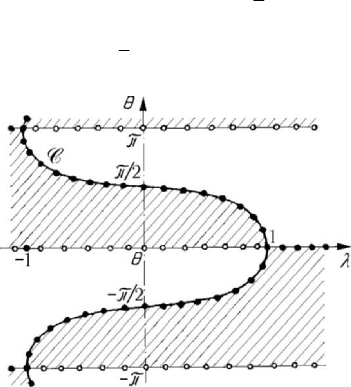
MECHANICAL SYSTEMS, CLASSICAL MODELS
462
point at which the velocity in the phase plane vanishes. The topological methods allow
to study the general topological properties of the phase trajectories defined by the
equation (6.2.39'). Taking into account the form of the phase trajectories in the
neighbourhood of the points of stable equilibrium (
1h
=
− ), such a singular point is
called centre; analogous considerations lead to the denomination of saddle point for a
singular point of labile equilibrium (
1h
=
).
Figure 7.24. Topological structure of the phase trajectory of a simple
pendulum in motion of rotation.
The topological structure of the phase trajectories may vary for some particular
values of the parameter which appears in a first integral. After H. Poincaré, we
introduce the parameter in the differential equation in the form
(, ) (, )/
f
qVqqλλ=−∂ ∂ , the positions of equilibrium being situated along the curve
C of equation (, ) 0
f
q λ = (Fig.7.23). For various values of the parameter λ one
obtains three positions of equilibrium (for
λλ
′
=
there correspond the points
123
,,PPP
′′′
of ordinates
123
,,qqq
′′′
) or one position of equilibrium (for λλ
′′
=
there
corresponds the point
P
′′
of ordinate q
′
′
); one passes from three positions to only one
position by critical values of the parameter
λ (
cr cr
,λλλ
′
′′
=
), to which correspond the
points
cr cr
,PP
′
′′
, of ordinates
cr cr
,qq
′
′′
, and the points ,PP
′
′′
of ordinates ,qq
′′′
,
respectively. Noting that
d/d (,)/ (,)
q
qfqfq
λ
λλλ
′
′
=
− , it follows that the critical
points correspond to the solutions of the equation
(, ) 0
q
f
q λ
′
=
(for which the tangent
to the curve
(, ) 0
f
q λ = is parallel to the axis
Oq
), assuming that (, ) 0
f
q
λ
λ
′
≠
. One
may thus state that the points of equilibrium appear and disappear two by two. We
suppose that the curve
C is a Jordan one, which divides the plane in two regions. We
notice that a straight line
λλ
′
=
pierces the curve C, for instance at the point
3
P
′
; if
(, ) 0
f
q λ
′
>
, hence if (, ) 0
q
Vqλ
′′
<
, below the curve C, then, for q increasing,
3
(,) 0
q
Vqλ
′′ ′
=
on C and (, ) 0
q
Vqλ
′
′
>
, over the curve C. It follows that
3
(,)Vq λ
′′
represents an isolated minimum of the potential energy, and the Lagrange-Dirichlet
theorem allows to state
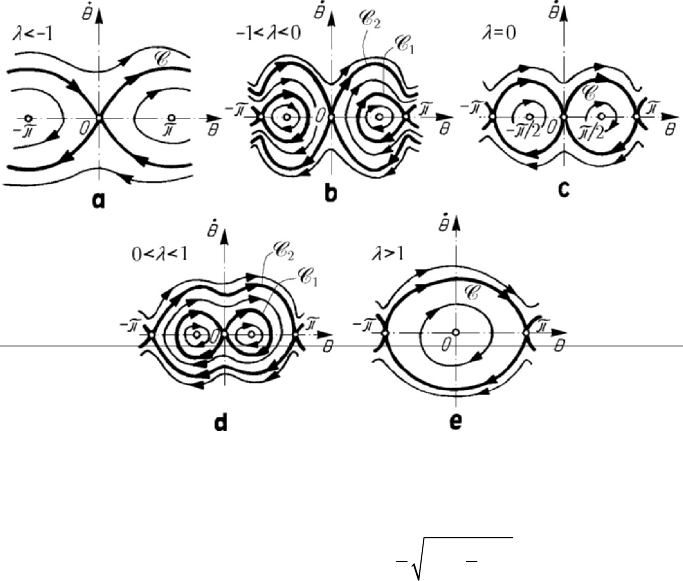
Problems of dynamics of the particle
463
Theorem 7.2.4 (Poincaré). The positions of equilibrium of a particle which moves after
the law
(, )qfqλ
=
in a conservative field are stable if the domain (, ) 0
f
q λ > is
under the curve
(, ) 0
f
q λ = , 0q > , 0λ > , and labile if this domain is over that one
(in Fig.7.23 the hatched domain corresponds to
(, ) 0
f
q λ > ).
Let us apply these results to the case of the simple pendulum in a motion of rotation
(see Subsec. 2.2.2), governed by the equation (7.2.24') of the form
(, ) (cos )sin
f
θθλ θλθ==−
. The curves C are given by the straight lines 0θ =
and
θπ=± and by the curve arccosθλ
=
. Applying the Theorem 7.2.4, we find
stable branches of the curve
C (the points of equilibrium of centre type are denoted by
whole little circles, i.e.,
arccosθλ
=
and 0θ
=
, 1λ > , and θπ
=
± , 1λ <− ), as
well as labile branches (the points of equilibrium of saddle type are denoted by empty
little circles, i.e.,
0θ =
, 1λ > and
θπ
=
±
, 1λ
<
− (Fig.7.24). The points
0θ =
,
1λ = and θπ=± , 1λ =− are points of ramification of the equilibrium, while the
values
cr
1λ
=
± are critical values (of bifurcation) of the parameter λ , corresponding
to those points. Taking into account (7.2.24'), it results that
0λ > , the domains of the
figure being thus restraint; as well, to have
1λ
<
the angular velocity ω must be
sufficiently great. If a separation line passes through the singular point
0θ =
, 0θ = ,
then the first integral (7.2.24'') becomes
Figure 7.25. Phase space representation of the motion of a simple pendulum in rotation for
various values of the parameter λ : 1λ
<
− (a); 10λ
−
<< (b);
0λ
=
(c); 01λ
<
< (d); 1λ > (e).
22
sin 2 (1 cos )θθλθ=−−
,
2
2sin cos
22
θθ
θλ
=
±−
;
(7.2.30)
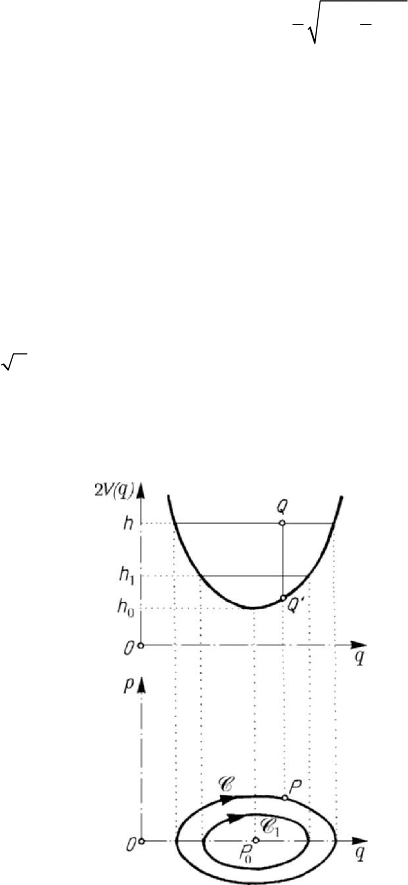
MECHANICAL SYSTEMS, CLASSICAL MODELS
464
if such a line passes through the singular points
0θ
=
, θπ
=
± , then the respective
first integral has the form
22
sin 2 (1 cos )θθλθ=++
,
2
2cos sin
22
θθ
θλ
=
±+
.
(7.2.30')
For 1λ <− , the singular points of saddle type 0θ
=
, θπ
=
± become singular points
of centre type (Fig.7.25,a), passing through
cr
1λ
′
=
− ; for 10λ
−
<< appear two
separation lines
1
C and
2
C , the first of those ones surrounding two centres, while the
point
O becomes a singular point of saddle type (Fig.7.25,b). If 0λ = , hence if
ω →∞, then the curves
1
C and
2
C coincide with the curve C and form only one
line of separation; in this case, the centres are of abscissae
/2θπ
=
± (Fig.7.25,c). For
01λ<< one obtains two separation lines
1
C and
2
C , corresponding the equations
(7.2.30) and (7.2.30'), respectively, which pass through the singular points of saddle
type
0θ =
, 0θ = , and
0θ
=
, θπ
=
± , respectively; in the interior of the loops of
the curve
1
C there exist two other singular points of centre type, having the abscissae
2 arccosθλ=±
(Fig.7.25,d). If
cr
1λλ
′
′
=
= , then the curve
1
C coincides with the
singular point
O , which becomes a point of centre type; for 1λ > remains only one
separation line
C (Fig.7.25,e). We observe thus that the separation lines correspond to
phase trajectories with different topological aspects.
Figure 7.26. Potential function versus generalized co-ordinate diagram.
The above considerations allow to state, without demonstration,
Theorem 7.2.5 (Poincaré). The closed phase trajectories of a particle which is moving
after the law
(, )qfqλ= in a conservative field may surround only an odd number of

Problems of dynamics of the particle
465
singular points, the number of centres being greater than the number of singular points
of saddle type.
Sometimes, it is difficult to build up phase trajectories by analytical methods, so that
approximate methods, i.e., graphical or grapho-analytical methods are necessary. Thus,
we may give a graphic representation of
2()Vq as function of q (Fig.7.26); drawing a
parallel of applicate
1
h to Oq , we may measure the difference 2()QQ V q h
′
=
− . By
the formula (6.2.40), the radical of this difference allows to specify the representative
point
P
in the phase plane, setting up the phase trajectory C by points. Starting from
1
hh= , we obtain the curve
1
C a.s.o.; to
0
hh
=
corresponds the singular point of
centre type
0
P .
Figure 7.27. Phase space representation of the motion of a simple
pendulum in a resistent medium.
In the case of a dissipative mechanical system with a single degree of freedom, of
equation
() ( )qfq Fp=+ , () 0pF p
≤
, we start from the considerations made in
Chap. 6, Subsec. 2.2.5. Multiplying this equation, which corresponds to linear or non-
linear damped free oscillations, by
dq and integrating along a closed phase trajectory,
it results
d()d()d0pp fq q Fp q
=
+=
∫∫ ∫
;
noting that
()d 0fq q=
∫
too, we get
()d ()d 0
T
Fp q Fppt
=
=
∫∫
,
where we have integrated on a time interval equal to a period
T . Because the product
()pF p maintains a constant sign, it results that we cannot have such a relation, and the
motion cannot be periodical.
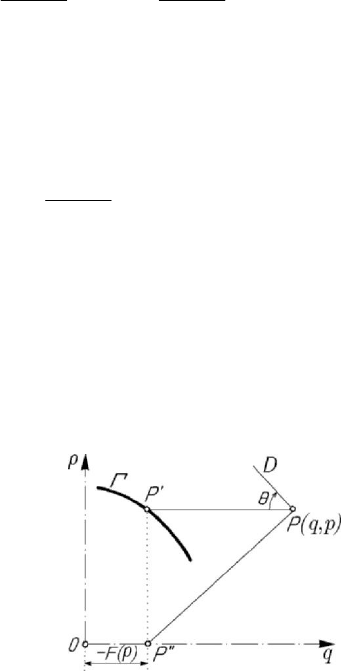
MECHANICAL SYSTEMS, CLASSICAL MODELS
466
We have seen in Subsec. 1.3.3 that, in the case of the motion of the simple pendulum
in a resistent medium, the angular velocity is given by (7.1.53''); the condition
0
0θθ=
≷ for 0θ = leads to
()
2
22
22 2 2
0
44
22
ecos2sin
41 41
k
k
kk
θ
ωω
θθ θ θ
⎛⎞
=− +
⎜⎟
++
⎝⎠
∓
∓
,
(7.2.31)
where the signs
± correspond to
0
0θ
≷ , respectively. The points 0θ =
, nθπ= ,
n ∈ , correspond to positions of equilibrium; the equilibrium is stable for n even
(the corresponding singular points are of focus type), while for
n odd the equilibrium
is labile (there correspond singular points of saddle type (Fig. 7.27)). If
()
2
2
22
0
4
2
1e
41
kn
n
k
π
ω
θ
=+
+
, n odd,
(7.2.32)
then we notice that for
0
01
θθ<
the particle oscillates, the motion being damped
around the stable position of equilibrium
0θ
=
, 0θ
=
; if
0
01
θθ=
, then one obtains
the asymptotic motion of a particle. For
0
01 03
θθθ<<
the particle effects a complete
rotation and then its oscillatory motion is damped; in general, if
00
0, 2
n
n
θθθ
+
<<
, n
odd, then the particle effects (1)/2n
+
complete rotations, passing then in a regime of
damped oscillations around a stable position of equilibrium.
Figure 7.28. Application of Liénard’s method in a phase space representation.
As in the case of conservative systems, in the case of non-conservative (dissipative)
systems we may use approximate methods of phase trajectories in the phase plane. For
example, in the case in which
()
f
qq
=
one may use Liénard’s method. Thus, one
draws first the curve
Γ of equation ()qFp
=
− (Fig.7.28); starting from the
representative point
(, )Pqp , one draws PP
′
, P Γ
′
∈
, parallel to Oq , and then
PP
′′′
, parallel to Op , POq
′′
∈
. A perpendicular D at P to PP
′
′
is inclined with
respect to
Oq by the angle θ given by
[
]
tan ( ) /qFp pθ
=
+ ; taking into account
(6.2.43), it results that the straight line
D defines the slope of the phase trajectory at

Problems of dynamics of the particle
467
P . Step by step, starting from an initial position, we obtain a polygonal line which
approximates the searched phase trajectory. We mention also other approximate
methods of computation, e.g., Drobov’s method, Pell’s method, the “delta” method etc.
In the above conditions, we have supposed that
() 0pF p
≤
, hence that this product
has a constant sign. But if this product is positive for small values of
p
, then the state
of equilibrium is not yet known, a motion being developed starting from this state; if the
product becomes then negative, the damping force being opposite to the velocity for
great values of
p , then the amplitude begins to be damped. The respective motion is
automaintained and will be considered in Chap. 8, Subsecs 2.1.4 and 2.2.7.

Chapter 8
DYNAMICS OF THE PARTICLE IN A FIELD OF
ELASTIC FORCES
In the problems studied till now, we considered – especially – the action of a
gravitational field (a field of parallel forces, the supports of which pass through a fixed
point situated in a plane at infinity) on the motion of a particle. We consider now the
case in which the particle is acted upon by central forces (the supports of which pass
through a fixed point at a finite distance). First of all, the general case of arbitrary
central forces is presented, then the cases in which – after Bertrand’s theorem – the
orbit is a closed curve (the case of elastic forces and the case of forces of Newtonian
attraction are considered). In this chapter we study, in detail, the motion of a particle in
a field of elastic forces.
1. The motion of a particle acted upon by a central force
In what follows, we firstly give some general results concerning the equations of
motion of the particle subjected to the action of a central force; we make also a
qualitative study of the trajectory. Then it is shown that the problem of two particles
leads to such a case of motion.
1.1 General results
The study of the motion of a particle subjected to the action of a central force leads
to Binet’s equation and formula, for which one obtains interesting qualitative results;
Bertrand’s theorem puts in evidence the two cases in which the trajectory is a closed
curve.
1.1.1 Central forces. Binet’s equation
Let us consider a particle
P
acted upon by a central force
F
; the equation of motion
is of the form
mF
r
=
r
r .
(8.1.1)
As it was shown in Chap. 6, Subsec. 1.2.6, in this case the trajectory is a plane curve
C;
taking the plane of the curve as
12
Ox x -plane and using the results in Chap. 5, Subsec.
1.2.4, we may write the equations of motion in polar co-ordinates in the form
469

MECHANICAL SYSTEMS, CLASSICAL MODELS
470
(
)
2
mr r Fθ−=
,
(
)
20mr rθθ
+
=
.
(8.1.1')
The second equation leads to the first integral (corresponding to the formula
(6.1.59))
2
2 rrvC
θ
θ===
Ω
,
20
00 0 00 0
sin constC r rv rv
θ
θα=== =
,
(8.1.2)
Figure 8.1. Particle acted upon by a central force.
where
Ω is the areal velocity of the particle P , the constant C being specified by the
initial conditions (Fig.8.1)
00
()rrt= ,
00
()tθθ= ,
00
()vvt
=
,
00
()tθθ=
,
000
(, )α
=
rv .
(8.1.1'')
Taking into account (8.1.2), the first equation (8.1.1') may be written in the form
mr F
=
,
()() ()
2
2
3
,,,; ,,,; ,,,;
mv
mC
Fr r t Fr r t Fr r t
r
r
θ
θθ θθ θθ=+=+
(8.1.3)
too, where we have introduced the apparent force
F
(we notice that the supplementary
force
2
/mv r
θ
is of the nature of a centrifugal force); the system of differential
equations (8.1.2), (8.1.3) determines the functions
()rrt
=
, ()tθθ
=
, the three
integration constants which appear being specified by initial conditions. If
(,;)FFrrt= , then the motion along the radius vector is given by the unidimensional
equation of Newton, where the apparent force
F is used, the angle θ being then
obtained from the integral of areas.
Successively, we have
(
)
2
ddd1
ddd
rCr
rC
r
r
θ
θθθ
== =−
,
(
)
(
)
222
222
d1 d1
dd
C
rC
rr
r
θ
θθ
=− =−
and, replacing in the equation (8.1.3), we obtain Binet’s equation (we suppose that
/0FFt≡∂ ∂ =
)

Dynamics of the particle in a field of elastic forces
471
(
)
22
22
d1 1
d
Fr
rr
mCθ
+=−
,
(
)
,,,FFrrθθ=
;
(8.1.4)
analogously, by eliminating
r and θ
from the expression of the force F , we get a
differential equation of second order, which determines the trajectory of the motion in
the form
12
1
(; , )
f
CC
r
θ= .
(8.1.4')
The initial conditions
0
12
0
1
(; , )fCC
r
θ =
,
00
0
12
0
cot
(; , )
r
fCC
Cr
α
θ
′
=− =−
,
(8.1.4'')
where we have put
00 0
cosrv α=
and /
f
f θ
′
≡
∂∂, allow to determine the integration
constants
1
C
and
2
C
. The integral of areas specifies the motion on the trajectory in the
form
0
0
2
12
1d
(; , )
tt
C
f
CC
θ
θ
ϑ
ϑ
=+
∫
.
(8.1.5)
Noting that
d(/)d[(/)]dFr rr Fr⋅= ⋅ =Fr r r , the theorem of kinetic energy
leads to
0
2
2
0
(,,,;)d
22
r
r
mv
mv
Ftρθρθ ρ−=
∫
.
If (, )FFrθ=
, hence if ()FFr
=
, then we may write a first integral of energy,
hence a first integral of Binet’s equation in the form
(
)
0
2
2
0
22
d1 1 1 2
()d
d
r
r
vF
rm
rC
ρρ
θ
⎡⎤
⎡
⎤
+= +
⎢⎥
⎢
⎥
⎣
⎦
⎣⎦
∫
,
(8.1.6)
noting that
22222 22
/vrr rCrθ=+ =+
; we may obtain this result multiplying both
members of Binet’s equation by
d(1 / )/dr θ and integrating. The given force is, in
this case, conservative and we may introduce the simple potential
()UUr= , so that
() () d /dFr U r U r
′
== . The first integral (8.1.6) becomes
(
)
(
)
22
22 2
2
d1 d
()
22d d
2
mr mC mC r
Ur h
r
r
θθ
⎡⎤
===+
⎢⎥
⎣⎦
,
2
2
() ()
2
mC
Ur Ur
r
=−
,
2
0
0
()
2
mv
hUr=−
,
(8.1.6')
